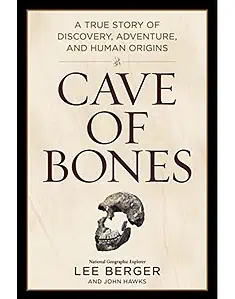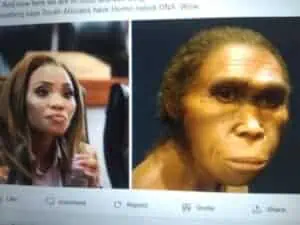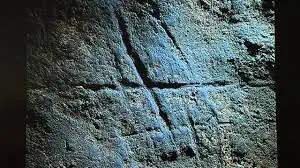Lee Berger announces Homo naledi used special markings for guidance in the dark cave system
 Dr. Lee Berger is a professor of evolutionary science at the University of Witwatersrand in South Africa. He is also on the National Board of the National Geographic Society, and is a designated NatGeo Worldwide Explorer. Dr. Berger is best known for having co-discovered two different hominin species – Australopithecus sediba in 2008 and Homo naledi in 2012. Both were found in South Africa.
Dr. Lee Berger is a professor of evolutionary science at the University of Witwatersrand in South Africa. He is also on the National Board of the National Geographic Society, and is a designated NatGeo Worldwide Explorer. Dr. Berger is best known for having co-discovered two different hominin species – Australopithecus sediba in 2008 and Homo naledi in 2012. Both were found in South Africa.
We have covered Dr. Berger and Homo naledi extensively over the years at Subspecieist. Our latest article from March 31,
Homo naledi culture, stone tools, DNA? Lee Berger teases huge announcement any day now
 Lee Berger has been dropping hints for weeks. Now he’s explicitly stating, stay tuned for something big about to come out.
Lee Berger has been dropping hints for weeks. Now he’s explicitly stating, stay tuned for something big about to come out.
Dr. Berger was a guest on Australian Radio on March 20. He was in Brisbane, Australia for a paleo-anthropology conference, the World Science Festival, March 24-26:
Professor Lee Berger has been leading some of the most revolutionary explorations, with ground-breaking expeditions across Africa. He joins Brian Greene to discuss the major discoveries of the last two decades in the search for human origins.
Berger further stated on Australia Radio:
I announced in December, that we found fire. Within the next couple of months you are going to see extraordinary discoveries that we made. We’re on the verge of for the first time in human history being able to examine, a non-human species with culture.
Today Dr. Berger held a worldwide press conference at Stony Brook University in Long Island, New York. Stony Brook has a longstanding first rate human evolution department and has sponsored numerous human origins forums over the years.
Berger detailed how the team had discovered markings on the cave walls.
From CNN, June 5,
Mysterious species buried their dead and carved symbols 100,000 years before humans
During the work to identify the cave burials, the scientists also found a number of symbols engraved on the cave walls, which are estimated to be between 241,000 and 335,000 years old, but they want to continue their testing for more precise dating.
The symbols include deeply carved hashtag-like cross-hatchings and other geometric shapes. Similar symbols found in other caves were carved by early Homo sapiens 80,000 years ago and Neanderthals 60,000 years ago and were thought to have been used as a way to record and share information.
During his press conference Berger showed photographs of crosshatch markings in the Dinaledi chamber.
Crosshatches are markings used by archaic hominins, including Neanderthals at Gibraltar. Neanderthals were also known to use chevron markings.
From the BBC, September 2014,
Neanderthal ‘artwork’ found in Gibraltar cave
The pattern, which bears a passing resemblance to the grid for a game of noughts and crosses, was inscribed on a rock at the back of Gorham’s Cave.
Berger is quoted at Yahoo News:
[The crosshatch markings] “That would mean not only are humans not unique in the development of symbolic practices, but may not have even invented such behaviours…”
Team member Professor John Hawks of the University of Wisconsin, and co-author of the new book with Berger, “Cave of Bones,” is quoted:
“There’s an intentionality to making a mark. But whether that mark was embedded in some system of meaning, we can’t see.
Agustin Fuentes is a professor of anthropology at Princeton University. He was a member of the Berger team. He is also quoted in the Yahoo News piece and puts even heavier importance on the markings:
“Burial, meaning-making, even ‘art’ could have a much more complicated, dynamic, non-human history than we previously though.”
Fuentes also Tweeted out:
Do large brains explain social complexity in the hominins? Maybe not.
Fuentes is the lead author of a paper at Biorxiv just released with Berger, Keneiloe Molopyane (pronounced – Ken-yie-lo-ee) et.al.
Burials and engravings in a small-brained hominin, Homo naledi, from the late Pleistocene: contexts and evolutionary implications
 The evidence from Dinaledi push back the temporal origins of… the creation of meaning making with a small-brained species and thus challenge key assumptions about the role and importance of encephalization in human evolution.
The evidence from Dinaledi push back the temporal origins of… the creation of meaning making with a small-brained species and thus challenge key assumptions about the role and importance of encephalization in human evolution.
Note – encephalization simply means brain development and growth.
Fuentes et.al. continue:
This suggests that the hominin socio-cognitive niche and its relation to meaning-making activities is more diverse than previously thought. The association of these activities in subterranean spaces accessed and modified by the small brained species Homo naledi impacts assertations that technological and cognitive advances in human evolution are associated solely with the evolution of larger brains.
Modern Africans could be admixed with Homo naledi
The Durvasula – Sankararaman study released in January 2020 found that Africans have as much as 19% archaic ghost species DNA admixture.
Homo naledi is at ~550cc brain size. In comparison Chimpanzees are at 350cc, Homo habilis was at 600c, and Homo erectus 900 to 1,100cc.
Professor Steven Churchill, a member of the Berger team, quoted on YouTube at the Dissenter, October 2022:
 It has a small brain. 550 cubic centimeters. The average for Homo erectus is about 900 cubic centimeters. So, it has a brain about the size of a Gorilla’s brain. It’s relatively small-bodied. There are aspects of its body that are very primitive… these are features that we see in the Australopiths. A little ape man if you will…
It has a small brain. 550 cubic centimeters. The average for Homo erectus is about 900 cubic centimeters. So, it has a brain about the size of a Gorilla’s brain. It’s relatively small-bodied. There are aspects of its body that are very primitive… these are features that we see in the Australopiths. A little ape man if you will…
What’s interesting is a work that’s been done on the genome of people who are indigenous to Africa… what they call a ghost lineage which contributed genetically to our lineage. That could be Naledi,
Average modern human brain size is 1,350cc. Europeans are admixed with Neanderthals at 1,450cc. Asians are admixed with Denisovans at 1,500cc.
Martha Christina, a genetics researcher in South Africa agrees that Homo naledi genes could show up in modern Africans:
Many South Africans have morphological traits, resembling those of Homo naledi. These traits are prevalent especially in southern Africans, some members of the African population, within the borders of the Republic of South Africa, who are now scattered across the 9 provinces.
See our article from October 2022: “Homo naledi awe-inspiring morphological traits, yes, definite common #1 traits with South African populations”




From the abstracts I’ve read — just those and the articles of scientists who have read the full papers — the notion that Homo naledi made its mark on the cave walls appears to be purely speculative. The estimate of it to be “between 241,000 and 335,000 years old” seems to be without evidentiary foundation whatsoever. That begs the question: In 300,000 years somebody besides naledi couldn’t have come along and scratched out its graffiti? Surely after all this time we have some smattering of evidence that this ain’t so, that’s what you’re going to need if this grandiose claim is to be believed.
The initial claims that naledi “buried” its dead is equally uncompelling. In the TWO — count’em two — burials I’ve seen referenced, both had remains of multiple individuals in the burial “depressions.” That’s what you’d find in a natural deposit, you know. . . .
I’m hoping this is only the first salvo of this belated naledi drama. Yes, naledi’s very existence is paradigm-breaking and changes our understanding forever. Nothing can change that now. But the latest reveals so teased and advertised so far seem lame . . . incredibly unconvincing and lame. *sigh*
Better to come I hope ?
The pillar scratchings are clearly made by persistent intelligence. Despite rumors of them being Twitter hashtags ;^), their meaning is unknown, their source is unknown, the dating is unknown. Anything beyond that is unscientific speculation. Weaving this into any kind of narrative at this point reeks of what it is — intellectual desperation.
For the objective viewer, it’s hard to categorize a couple of 11-inch deep depressions as burial sites, especially since the remains of almost all of the cave specimens are disarticulated in ways inconsistent with intact decomposition. Them bones, they be scattered. Explaining away one amalgam of four individuals in one depression as possibly “burial over burial” is just the purest kind of wishful thinking. Naledi so revered the dead but repeatedly interred burial sites? Man, that’s some cringey explanation you got going there.
The desperation reaches a crescendo when Berger posits that the CT of a single strata-encased curved rock implies a tool of some kind. No corroborating evidence whatsoever it was a tool, and there are zero companion specimens.
https://www.youtube.com/watch?v=fFbgQhY4Yxw
Berger is now talking about shutting down the site, “preserving it for the future.” That doesn’t sound to me as if they expect any revolutionary breakthroughs, which is what you would expect if their sensational narrative has any legs.
And here’s more warning flags: This site was discovered 10 years ago. It was only the recent arrival of Berger’s personal presence that discovered, lo and behold, there was massive soot all over the cave walls. It was BERGER and his personal presence that found the pillar etchings it’s been claimed. Damn, all those touted female “qualified experts” mining the caves all that time, they must have been wearing blinders !
Further, it gives me no comfort that Berger has taken Agustin Fuentes as an ally. This is a PhD dude who attained all of his academic education 100 miles from his southern California house. He’s a radical politically-correct ideologue.
https://www.scientificamerican.com/article/heres-why-human-sex-is-not-binary/
https://www.lectures.iastate.edu/lectures/what-race-what-it-not-and-why-it-matters
https://blogs.scientificamerican.com/guest-blog/get-over-it-men-and-women-are-from-the-same-planet/
And his recent book:
Race, Monogamy, and Other Lies They Told You
The synopsis: It “counters these pervasive and pernicious myths about human behavior.”
“Presenting scientific evidence from diverse fields, including anthropology, biology, and psychology, Fuentes devises a myth-busting toolkit to dismantle persistent fallacies about the validity of biological races, the innateness of aggression and violence, and the nature of monogamy, sex, and gender.”
No corroborating evidence for his grandiose claims, Berger as The Man, sleeping with a bizarre intellectual bedfellow.
What a way to muck up what is probably the most significant paleoanthropology find of all time.
I apologize for waiting for the science to kick in.
Here’s something else I don’t get, you tell me where I’m going wrong here.
Berger says — and I believe him based on the photos he’s published — that there is massive charcoal evidence throughout the cave system.
Dating of the fire evidence and the carved etchings is critical in supporting his present claims that these are the artifacts of Homo naledi some 250 to 325,000 years ago.
But I’ve read that they are reserving carbon-dating in the caves for some indefinite hypothetical future. Whatever the case, they haven’t published any findings of it.
Why not carbon-date right here right now? According to Berger there’s plenty of material lying around.
You can find out TODAY if the charcoal dates older than the carbon-date limit of 50,000 – 60,000 years, and that tells us something we didn’t know before. And if it dates YOUNGER, Berger’s thesis of more ancient origins are invalid.
I get that reliably dating the pillar carvings could be problematic and long in coming.
But why not carbon-date some charcoal now? What are they waiting for?
Is this science or an advertising campaign?
Is this truly a “world heritage site” that feeds to the understanding of humanity or is it a posturing plaything for a select few?
If you have the time and interest, this somewhat nerdy archaeologist explains his take on the recent Homo naledi releases, more specifically the “burials.”
I found it interesting and enlightening with a folksy humanity.
I would start at 6:35, but if you want to skip his qualifications, some general explanations about site processing, and homage to his deceased archaeologist father, you could start at 24:00
https://www.youtube.com/watch?v=9iN9t393QQI
If you really want to cut to the chase with the critique conclusions by a real, professional, established archaeologist with extensive experience of burials, cut to the summary at 1:20:50.
All good points Duncan. We don’t know yet. I listened to Gutsick Gibbon today on the Berger announcement. She leans toward him being correct. And notably Chris Stringer is also seemingly signing on, though with caution.
BTW, you do know I have a very active YouTube channel now. Hope you check it out and leave comments there often. https://www.youtube.com/watch?v=uxMv9D7IpN4&t=404s